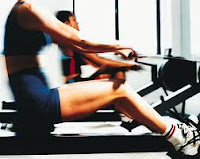HIIT Economy: 30s Intervals + 2:1 Work-To-Recovery Ratio Allow For Maximal Peak Oxygen Uptake at Minimal Power Output During HIIT Exercises in Advanced Trainees
 |
| We all know and follow the fundamental rules of the marketplace, but when we are in the gym we tend to forget about profit maximization and the minimal investment, maximal returns principle. |
Even if you don't belong to this group of miserably misguided souls, I believe there is this innate masochistic side in all of us that makes us believe that the degree of post-workout exhaustion is an adequate measure of the efficacy of a given workout. It does not matter if we are talking about classic cardio training, weight lifting or the high intensity interval training - all of them could benefit from goal-specific modifications, such as those that researchers from the Lillehammer University College in Norway have recently tested in a small scale intervention trial involving 13 well-trained male cyclists (Rønnestad. 2013).
Note: Your Tmax is the time to exhaustion during continuously cycling to exhaustion at the minimal power output (MAP) that elicits peak oxygen uptake (VO2max).
The goal Rønnestad and Hansen had had in mind, when they came up with the study design was to investigate the effect of interval durations of 30s, 50% of Tmax [Tmax = ], and 80% of Tmax on the corresponding time-periods the athletes would exercise at ≥90% of their peak oxygen uptake. The three workouts that were performed on three different occasions had a work-to-rest ratio 2:1 and the intensity during the active recovery periods was 50% of the minimal power output (MAP) that elicits peak oxygen uptake (VO2max).The latter, i.e. the time spent at a minimal power output that elicits peak oxygen uptake, was obviously also the criteria to define the "optimal" HIIT workout. After all, it can be expected that the "cardiovascular" (=fitness) benefits and the corresponding increases in the max. VO2 will be most pronounced, when you work out close to your individual VO2max without subjecting yourself to a potentially detrimental strain.
"diverge somewhat from the findings of Millet et al. (2003) [who] compared, amongst others, intermittent runs at MAP with a work duration of 30 s and 50% of Tmax with a 1:1 work:recovery ratio and a recovery intensity of 50% of MAP [and] found that work intervals lasting 50% of Tmax resulted in greater time ≥ 90% of VO2peak than work intervals of 30 s (~ 8 min vs. ~ 2.5 min, respectively)." (Rønnestad. 2013)According to the authors this difference is probably a direct consequence of the extended active rest periods in the Millet trial. While the study at hand used rest periods of 15s (50% of the time spent ad MAP intensity), the participants in Millet's study rested for 30s. Enough time for the heart rate to recover and the "workout economy to decline".
 |
| Suggested read: "Eight HIIT Sessions on the Rowing Ergometer Cut Body Fat, Increase Adiponectin, VO2Max & Performance in National Level Rowers - Workmatched Classic "Cardio" Does Nothing" | read more |
For the advanced trainee looking to increase his cardiovascular capacity, high intensity interval training should thus be the training method of choice and as the study at hand confirms, the most economic form of HIIT is one that maximizes the time spent in the magic >90% of your HR peak training zone, at minimal intensities.
References:
- Millet, GP, Candau, R, Fattori, P, Bignet, F, and Varray, A. VO2 responses to different intermittent runs at velocity associated with VO2max. Can J Appl Physiol 28: 410-423, 2003.
- Rønnestad BR, Hansen J. Optimizing interval training at power output associated with peak oxygen uptake in well-trained cyclists. J Strength Cond Res. 2013 Aug 12. [Epub ahead of print]



